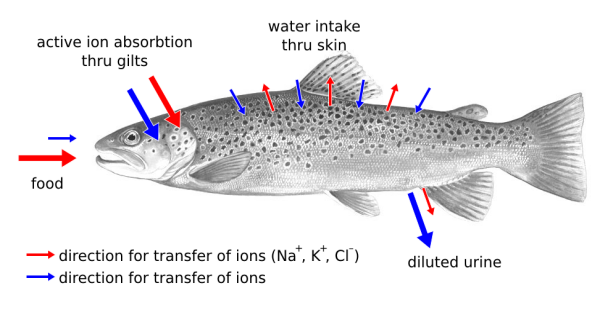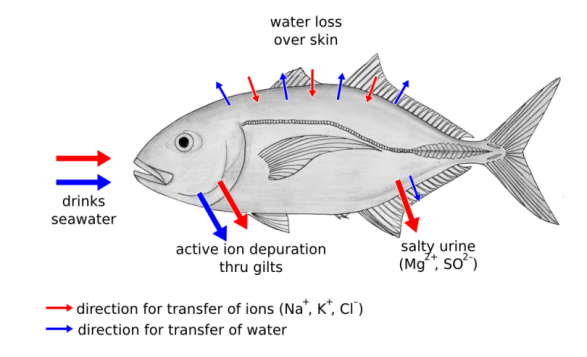Dictionary of Ichthyology


Carangoides bartholomaei osmoregulation below from Wikimedia Commons:
http://commons.wikimedia.org/wiki/File:Osmoseragulation_Carangoides_bartholomaei_bw_en.png (gilts = gills).
|
Dictionary of Ichthyology | |
|
| osmoregulation = maintenance of a proper balance of salts and water within an organism. Freshwater fish regulate hyperosmotically as they tend to lose salts and take up water. They have a glomerular kidney which secretes very dilute urine (up to 20% of body weight each day), kidney tubules are impermeable to water, sodium ions are actively pumped from the distal kidney tubules and across membranes of chloride cells (q.v.) in the gills while chloride ions passively follow the gradient established, and the sodium and potassium pump across the gills involves an exchange of ammonium ions for sodium or potassium ions so ammonia is eliminated while salts are gained. Marine fish regulate hypo-osmotically as they tend to gain salts and lose water. They have an aglomerular kidney which produces very little urine while secreting magnesium and sulphate ions, seawater is drunk copiously (up to 12% of body weight per day), sodium ions are actively pumped from the gut to body fluids and chlorine ions and water follow passively, the gut is relatively impermeable to magnesium and sulphate ions, the chloride cells actively secrete sodium and chlorine ions follow, and the gill membranes are relatively impermeable to water. Sharks use urea to maintain internal osmotic levels above sea water while excess salt from food is excreted via a rectal gland, (q.v.). Fish living in euryhaline waters have a glomerular kidney that can be shut down by arteriole constriction and chloride cells that can switch between taking up salt and secreting it. Based on www.csuchico.edu/~pmaslin/ichthy/xcrtn.html, downloaded 29 December 2003. |
|
Salmo trutta osmoregulation above from Wikimedia Commons:
http://upload.wikimedia.org/wikipedia/commons/b/b8/Bachforelle_osmoregulatoin_bw_en.png
and Carangoides bartholomaei osmoregulation below from Wikimedia Commons: http://commons.wikimedia.org/wiki/File:Osmoseragulation_Carangoides_bartholomaei_bw_en.png (gilts = gills). | |